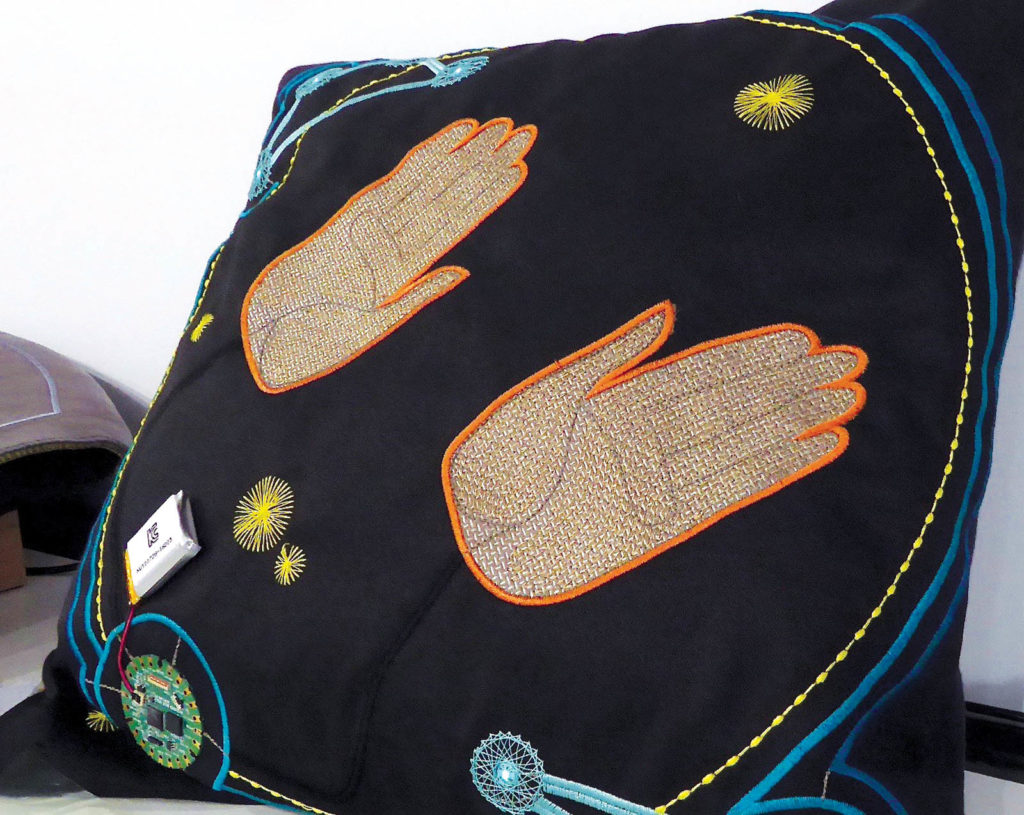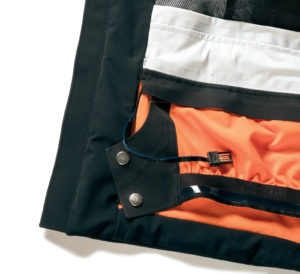Partnerships along the supply chain support new products and applications.
by Marie O’Mahony
British entrepreneur Richard Branson once said, “There are no quick wins in business; it takes years to become an overnight success.” This is certainly true for the development of innovative new textiles. Business owners who succeed in their efforts know that establishing long-term collaborations among partners all along the supply chain and the value network are critical to achieving their goals.
The first step on the way to success in innovation is recognizing that something has to be done differently, and it may not be obvious. But there are plenty of useful examples from research, manufacturing and retail that illustrate how the need for change is being recognized, and how new partnerships and practices can accomplish such change.

Making innovation work
The 7Sphere HYDRO_BOT smart sweat technology ski jacket uses an electronic membrane to pump moisture away from the body to the outside of the jacket where it can more easily evaporate. It promises to be ten times more efficient at removing moisture than more conventional membranes, protecting the wearer from post-activity chill.
The innovation was a Gold Winner at the 2019 international sporting goods trade fair ISPO. It was the end result of a successful partnership among several, mostly Swiss, industry participants that included Osmotex AG, technology innovator; Schoeller Textil AG, textile manufacturer; KJUS, Norwegian sportswear brand; Czech company Applycon, wearable electronics; the Swiss Center of Electronics and Microtechnology (CSEM), engineering R&D; and Swiss Federal Laboratories for Materials Science and Technology (EMPA), electro-chemistry, R&D and testing.
A glance through this list highlights the very different fields involved. Each has its own set and ranking of priorities so that for the textile manufacturer and brand designer, a soft handle may be high on the list, but less so, or not at all, for the electrical engineer, and so forth.
Applycon focuses on bringing together interdisciplinary knowledge for wearable technology and intelligent textiles, but it is dealing with rapidly advancing technologies and doubling the challenge by looking to integrate them.
Collaboration is key, as Milan Baxa, Applycon managing director, explains: “We aspire to be a significant force in the field of wearable electronics and its integration into mass production, and our collaboration with Osmotex represents an exciting innovation for us to be involved in.”
Osmotex wants to make the membrane even thinner and is also looking to integrate further technologies, such as sensors. Trond Heldal, director of R&D and operations for Osmotex, is aware of the roadblocks. “It’s like microcomputers were in the 1980s—no one knows how much is possible with very different skills coming together,” he says.
Interdisciplinary skills
Swiss company Forster Rohner AG has produced high-quality embroidery for haute couture, ready-to-wear and lingerie for decades, but more recently the company has added a new business unit. Forster Rohner Textile Innovations has filed patents for conductive yarns, providing the foundation for e-textile lighting and textile sensor developments using core competencies in embroidery.
The company describes its activities as “[combining] material science with visionary embroidery technology and electronics.” Lighting for interiors is a key market, due in large part to consumer acceptance.
The pace of technological change and its complexity gives rise to a greater need for interdisciplinary teams to overcome obstacles that are sure to come. Though trained as an electrical engineer, Adis Causevic, head of technical development, sees textile skills and knowledge remaining the core competencies within Forster Rohner. The length of time it takes to develop new products is an obstacle, he says, and with the pace of technology moving so fast, there is a very real risk of being copied.
However, once functionality and reliability have been established, other factors come into play. The consumer price would be one, but quality and the reputation that comes with a particular brand identity are increasingly important.

The value network
At the Association of the Nonwoven Fabrics Industry (INDA) RISE® 2018 conference, the European directive that introduces new restrictions on certain single-use plastic products, issued just months before this event, became one of the most hotly discussed topics, with many participants in the nonwovens industry already prepared with strategies to address it.
Proctor & Gamble sees addressing environmental impact as both a challenge and an opportunity. In its P&G Citizenship Report 2018, the company looked at sustainable innovation along with its supply chain working toward “driving innovation that is sustainable for both the business and the planet.”
In January 2019, it announced a partnership with Loop™ Industries Inc., a company that is the first of its kind offering a global packaging and shopping, circular-solution, e-commerce platform developed by the international recycling leader TerraCycle®. The agreement includes a “collect and recycle” circular solution with the introduction of reusable, refillable packaging on some of Proctor & Gamble’s most popular products.
Swedish retailer IKEA’s recent announcement that it plans to replace all virgin polyester textile products with recycled polyester by 2020 has made a considerable impact on the synthetic textile industry. Nils Månsson, material and innovation deployment leader for IKEA, says, “By recycling PET [polyethylene terephthalate] products, we’re giving them a second life. We also hope to inspire others to follow for a greater positive impact on people and planet.”
IKEA is one of the biggest customers for Outlast® Technologies, the phase-change material (PCM) company headquartered in Golden, Colo. It has already begun to include recycled materials in its PCM portfolio, using 100 percent recycled polyester to meet the Global Recycle Standard (GRS).

It’s not just technology
Taking account of environmental goals and the breadth of international reach, meeting global and local standards, addressing cultures, and considering current and future consumer expectations all make the challenge of introducing innovation a complex one. The three-staged view of smart materials allows the time and space for trial and error as the nascent market develops.
“You can’t focus on technology only,” says Mark Croes, consultant in hygiene and medical at Belgium-based Centexbel. “It has to be the whole supply chain.” Centexbel is a membership organization whose mission is to promote research and technological development with the intention of enhancing the cost-effectiveness, quality and production capacity of the Belgian textile industry. On behalf of its members, it undertakes R&D, product certification, product analysis, and material characterization and testing, as well as knowledge dissemination.
“Because Centexbel is industry-driven, the shorter the better—and five years is a long time,” says Croes. “Manufacturers in Belgium are looking to strengthen the whole supply chain.”
To address this need, the organization has broadened its scope, establishing Centexbel-VKC, a “one-stop shop” for the plastics value chain, offering integrated facilities for materials research, development, testing, recycling and training. New York City-based Makelab offers a semi-industrial pilot production line to accelerate the process of bringing together materials and processes from textiles to plastics and 3D printing.
These hybrid materials, each with its own provenance, come with a particular challenge in scaled manufacturing for production, as well as recycling and “end of life” issues. Addressing these early on can only be of benefit when it comes to establishing the supply chain for commercialization.
Dr. Volker Lutz, with the Smart Textronics Centre at ITA, RWTH Aachen University, Germany, says the center’s research starts with fiber production and goes through to the finished product. He says there is still a lot to be accomplished in understanding what is possible. Technology integration is important, creating a better alignment as materials and processes are brought together in preparation for manufacturing. Without integration, scale for production will become even more difficult as the pace of technological development continues unabated.
Marie O’Mahony is an industry consultant, academic and author based in Toronto, Canada.
 A detail from the Kjus HYDRO_BOT ski jacket, which uses an electronic membrane to pump moisture away from the body to the outside of the jacket where it can more easily evaporate. It promises to be ten times more efficient at removing moisture than conventional membranes.
A detail from the Kjus HYDRO_BOT ski jacket, which uses an electronic membrane to pump moisture away from the body to the outside of the jacket where it can more easily evaporate. It promises to be ten times more efficient at removing moisture than conventional membranes.
The innovation was the end result of a successful partnership among several, mostly Swiss, industry participants. Photo: Kjus HYDRO_BOT.
 TEXTILES.ORG
TEXTILES.ORG


